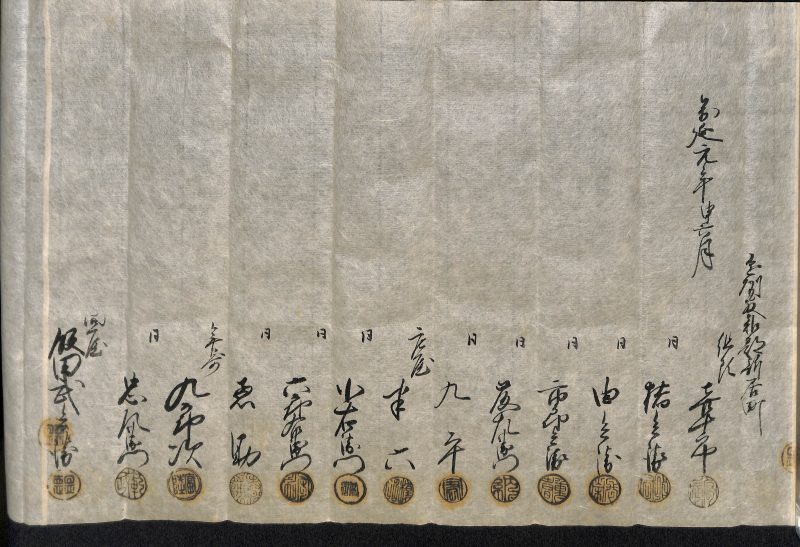Hello! How are you spending your weekdays? Please visit the Sake Museum. This month’s topic is about the tarukaisen cargo vessels and maritime accidents.
There are historical records known as “urategata” or “urajō” that tell us today about the conditions of the maritime accidents on the tarukaisen cargo vessels. When the vessels drifted ashore because they could not steer due to a typhoon, the villages made these accident reports. The contents of this report would determine whether or not there was negligence, so it contained a detailed account of the circumstances leading up to the accident.

Then, let’s see the urategata when the Tatsuyoshi-maru cargo vessel, owned by Tatsuya Kichizaemon, was in a maritime accident. The boatman of the vessel was Kamezō and it had a crew of 16. In the beginning of this report, there are descriptions for shipping of the Tatsuyoshi-maru, which was involved in a maritime accident. According to it, the Tatsuyoshi -maru left Osaka on 19 April 1860 to transport 3,000 casks of sake to Edo, arriving safely at Edo on 6 May and delivering the casks to a sake wholesaler. Then, on May 23, they set sail from Edo in an empty state for Osaka. However, the weather, which had previously been favorable, suddenly changed at around 14:00 noon on 10 June. However, the weather, which had previously been favorable,suddenly changed at around 14:00 noon on 10 June. The direction of wind from southeast changed to south and wind became gusty winds, and the crew was in mortal danger in front of high waves. Finally, the vessel was washed up on the beach near Arai-cho (present-day Kosai City, Shizuoka Prefecture), and the crew jumped into the water to escape and land. This historical record shows that the accident was caused by force majeure, with no negligence on the part of the ship’s captain or crew.

Then, how was the accident handled? Fortunately, all the crew were safe, but the vessel’s hull was badly damaged, and tools and other items were recovered by the local people. These were auctioned locally and part of the proceeds were cashed in. Gratuities and expenses for the local people who helped to deal with the accident were deducted, and the balance was paid to the owner of the ship. Then, it was distributed to the owners and investors according to the investment ratio of the vessel, and the handling of the accident is completed.

A considerable number of such accidents have occurred on the vessels owned by Tatsuya Kichizaemon. For example, the Tatsuyoshi-maru was rebuilt in October 1861, but it suffered another maritime accident in Edo Bay as early as July 1863. Thus, the ownership and operation of tarukaisen cargo vessels was always a matter of risk, but sake brewery in Kamigata still invested them to stabilize the distribution.
In this issue, we introduced the maritime accidents encountered by the Tarukaisen cargo vessels and their disposal. We have introduced the Tarukaisen several times in the past, so we would appreciate it if you could read it together with this time. We look forward to seeing you again next time!







Please come and see the large sakabayashi (cedar ball)!